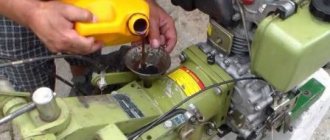Cooling of lubricating oil through oil heat exchangers is a more progressive direction. They are used on both diesel and gasoline engines (an example is the ZMZ 409 and ZMZ 514 engines). In liquid-oil heat exchangers (LOH), the oil is cooled by an intermediate coolant - liquid directly from the engine cooling system. Such engine oil cooling systems have a number of advantages compared to an air radiator cooling system, which explains their widespread use on foreign equipment.
Engine heat exchanger
Each engine in a modern car is equipped with turbochargers that do not operate outside a certain temperature range.
This applies to all systems in the car that contribute to the operation of the engine. When temperatures drop significantly, diesel fuel becomes thick, which significantly complicates not only starting the engine itself, but the operation of the engine as a whole. There are situations that are just the opposite - too active engine activity in the absence of cooling or heat removal. In such situations, significant overheating of the engine is possible, which also negatively affects the unit. Naturally, the risk of adverse consequences increases tenfold with systematic and prolonged overheating. Most of these cases end in a complete repair, starting from the stage of replacing liners and pistons and ending with the replacement of other parts. Modern passenger cars most often use so-called liquid cooling systems. These are closed cooling systems that have low noise levels but provide uniform cooling. In general, the following parts of the cooling system are responsible for maintaining optimal engine temperature:
- radiator with liquid that directly cools;
- oil radiator;
- heat exchanger;
- water pump (operates on the principle of taking heat from parts);
- thermostat (regulates the direction of movement of the liquid that produces cooling), etc.
The engine heat exchanger performs exactly the opposite function relative to the radiator. If a radiator is needed to carry out the process of an already heated liquid, then the heat exchanger helps heat the air that passes through it. This process is necessary to prevent the process that causes the engine oil to foam (air bubbles form when the oil heats up). This is the main problem when heating engine oil, as it ultimately leads to engine failure.
To avoid this kind of unpleasant situation leading to breakdown, the oil also needs constant cooling. If we carefully analyze the entire process of changing the oil temperature throughout the entire cycle, we will note that after being taken, the oil enters the heat exchanger specifically for cooling and only then is sent again in order to lubricate and cool the diesel engine.
Heat exchanger or how to understand that antifreeze has got into the oil!
Heat exchanger
is a technical device in which heat is exchanged between two media having different temperatures.
Let's just say frankly the weak point of all modern engines!
Mixing motor lubricant with engine coolant is a critical malfunction that requires immediate intervention and elimination. In other words, the car cannot be operated, only repaired. Although infrequent, this problem occurs on new and used cars. To avoid costly repairs, the car owner must clearly understand the procedure for his actions when oil is found in antifreeze.
The cooling system of the power unit is a network of channels passing through the block and cylinder head. It is sealed and therefore operates under pressure resulting from the heating and expansion of the liquid. The lubrication system has a similar structure, only the channels are narrower, and the pressure is created by an oil pump.
It is extremely important to monitor the levels and condition of technical fluids, oil and antifreeze.
There are several reasons why two different liquids mix:
- In cars with modern and complex engines, there is an element for cooling the engine lubricant - an oil cooler or, in other words, a HEAT EXCHANGER. This is where antifreeze and oil are mixed as a result of gasket failure.
- The gasket between the head and the cylinder block is the weak point of any engine. When the smallest crack appears in it, liquid with higher pressure penetrates into the “foreign” system. As a rule, oil enters the antifreeze because the oil pump “presses” harder than the pump. Although mutual penetration also happens.
- Cracks in the metal of the cylinder head itself.
Draining oil from systems filled with ammonia
In ammonia systems, immiscible oil is used to lubricate compressors. It is heavier than ammonia and settles at the bottom of the liquid separator, as a result of which it can no longer return through the suction line to the compressor. Thus, in such systems, oil is drained from the liquid separator into the oil receiver. To do this, shut-off valves are closed and the hot steam line is opened. At the same time, the pressure increases and the cold oil begins to heat up. Next, the oil is drained through the drain valve into the oil receiver; before the ammonia exits, the valve is quickly closed. It is also necessary to provide for the installation of a shut-off valve between the valve and the oil receiver. Before draining the oil, it opens and closes at the end of the process. It would be a good idea to take precautions during the oil draining procedure.
Why do you need to change heat exchanger gaskets on some Opel car engines?
Z16XER and Z18XER engines are often installed in Opel . Such motors have a heat exchanger , which is also often called an oil cooler . This part cools the engine oil . Antifreeze is used as the working medium . The heat exchangers are installed under the exhaust manifold on the oil filter housing . Naturally, this oil cooler has gaskets and o-rings . Over time, exposure to high temperatures causes destruction of gaskets and O-rings. In this case, oil may leak onto the engine housing , as well as directly into the cooling system of the machine.
Quite often, oil gets into the antifreeze, causing an emulsion to form that can severely clog the car’s cooling system. This in turn can damage the pump, thermostat, pipes and expansion tank. The emulsion settles on the inside of the cylinders and seriously corrodes the pipes. In this case, you have to carry out more expensive repairs to the car engine. In order to save money, as well as time for repair work, it is necessary to promptly check the condition of the antifreeze in the expansion tank of the machine, and also determine the presence of oil stains on the engine, specifically at the location of the oil cooler.
Heat exchanger gaskets are replaced in cases where:
- the expansion tank has darkened significantly;
- the liquid in the expansion tank has darkened (or oil stains have appeared on it);
- there is a smell of oil in the cabin when the engine is turned on;
- Directly under the oil cooler, streaks and oil stains are visible.
You need to know one important fact. When a car engine has been running for a long time and its mileage is more than 150,000 kilometers, oil can get into the tank even after changing the heat exchanger gaskets. This is due to the fact that when the engine has worked for a long time, it is difficult to understand where the oil is leaking from and getting into the antifreeze. This problem is often solved by replacing the oil pump gaskets .
The cost of replacing gaskets in the oil cooler of various types of Opel cars can be found and ordered in our service:
What is a KAMAZ oil heat exchanger?
Oil heat exchanger (liquid-oil heat exchanger, liquid-oil heat exchanger) - a unit of lubrication and cooling systems for high-power diesel power units; a heat exchanger of a special design built into the engine liquid cooling system that provides cooling of the engine oil due to heat exchange with the coolant flow.
The lubrication system of powerful KAMAZ diesel units operates in difficult conditions; the oil is constantly exposed to high temperatures and gradually loses its quality. In certain modes, engine oil may overheat, which leads to a decrease in its viscosity and lubricity, as well as to intense decomposition and burnout. Ultimately, overheated oil impairs engine performance and can even cause engine failure. This problem is solved by introducing an element for oil cooling - a heat exchanger - into the lubrication system of KAMAZ engines.
The oil heat exchanger is an integral part of the engine lubrication and cooling systems; it ensures the removal of excess heat from the oil due to active heat exchange with the washer flow of coolant (coolant). That is why devices of this type are called liquid-oil heat exchangers, or LHT. This unit performs several functions:
- Partial oil cooling at engine temperature less than 100 degrees;
- Cooling of all oil supplied to the engine at a temperature within 100-110 degrees;
- Reducing oil consumption due to waste and extending its service life;
- Ensuring optimal temperature conditions for various engine systems - thanks to liquid coolant, the oil temperature never drops below the coolant temperature, which contributes to more uniform heating of engine parts, reduction of mechanical stress, etc.;
- Simplifying the design of the oil cooling system and reducing the cost of the engine while ensuring normal performance characteristics.
Today, heat exchangers are installed in most KAMAZ diesel engines that comply with Euro-2 standards and higher; they play an important role in ensuring normal characteristics of the power unit in all operating modes. A faulty heat exchanger needs to be repaired or completely replaced as soon as possible, but before buying a new part, you should understand the design and operation of these devices.
Advantages of LMC compared to a radiator
1
.
As a rule, the dimensions and weight of the lubrication system are reduced; 2
.
Provides intensive heating of the oil after starting the engine; 3
.
Due to the low hydraulic resistance of the heat exchanger, an oil bypass valve is not required; 4
.
Thanks to a slight change in the thermal state of the cooling system, a stable temperature of the engine oil is ensured and it is protected from overcooling during winter operation; 5
.
As a result of rapid warming up of the oil after starting the engine and maintaining its stable temperature in the lubrication system, the amount of low-temperature precipitation (deposits) in the oil is reduced, which helps reduce wear of engine parts; 6
.
The use of long pipelines is eliminated, since the heat exchangers are located on the engine block or built into the cooling jacket; 7
.
There is no need to turn off the heat exchanger when operating in winter, since exposure to low ambient temperatures is eliminated; 8
.
The negative impact of lubricating oil on the engine cooling radiator is eliminated, which occurs in the event of an emergency leakage of oil from the oil radiator when installing it in the air duct; 9
.
Maintenance of the cooling system during operation is simplified due to freer access for cleaning the external surfaces of the engine cooling radiator. 10
.
The pressure in the oil line does not decrease, as when using an oil cooler. eleven
. When the engine is pre-heated in winter using a heater built into the cooling system, the oil in the oil filter also warms up, which has a good effect on the first seconds of start-up.
All this will increase the service life of the engine and oil, because it will operate at a more stable temperature. After all, it is known that under load the oil is hotter than the coolant by 20-30 degrees or more, because it is directly sprayed onto hot engine parts (pistons, cylinders) and cools them. And above normal, hot oil becomes more liquid and lubricates parts worse, which threatens them with increased wear and even sticking, and quickly loses its properties (aging).
Design and principle of operation of KAMAZ oil heat exchangers
Currently, only shell-and-tube (tubular) type LMCs of various modifications are used on KAMAZ engines. Structurally, this unit is quite simple, it consists of the following parts:
- Housing (casing);
- Core with deflector;
- Supply manifold;
- Outlet manifold.
The basis of the design is an aluminum cylindrical body (casing), on the wall of which there are channels and mating surfaces for connection to the oil filter block (installation is carried out through gaskets). The ends of the casing are closed with special covers with pipes - inlet and outlet manifolds, the first ensures the supply of coolant from the water jacket of the cylinder block into the housing, and the second takes the liquid back to the engine cooling system. The housing has drillings and channels for the installation of bypass valves, which ensure oil bypass bypassing the heat exchanger if its core is clogged.
A core is installed inside the body - an assembly of thin-walled copper or brass tubes placed in a package of transverse metal plates. On the core there are five plates with a protruding part, which divide the entire part into four sections, which ensures a change in the direction of oil flow. On one side of the core there is a flange, which during installation rests against the end of the housing; on the opposite side, the flange has such a diameter as to fit tightly inside the casing, and there are several o-rings on it. This design ensures separation of the coolant and oil flow, preventing them from mixing. And to ensure the correct direction of oil flow, a deflector is located on one side of the core - an open metal ring with a slot.
Disadvantages of LMT
1
.
LMC is less efficient than an air-oil radiator. The efficiency of liquid coolant largely depends on the temperature of the coolant supplied to cool the oil, and therefore on the temperature difference between the temperature of the liquid and the oil. This difference when using LMC is insignificant and amounts to 5...7 °C. With such a temperature difference, the use of liquid metal can be justified only if it has high heat transfer, otherwise the required cooling surface and dimensions will be very significant. 2
. Violation of the tightness of the liquid coolant can lead to oil penetration into the coolant and oiling of the cooling jacket, and, consequently, to a malfunction of both the lubrication system and the cooling system and engine failure.
Applicability of oil heat exchangers on KAMAZ vehicles
LMC are installed only on KAMAZ 740 diesel engines of various modifications of Euro-2, 3 and 4 environmental classes. Today, two types of heat exchangers are used:
- Catalog number 740.11-1013200 - short modification;
- Catalog number 740.20-1013200 - long modification.
The difference between these parts lies in the design of the collectors and, therefore, in the method of connection to the cooling system. In a short LMC, the outlet manifold has only a mating surface at the end for connecting the pipe using bolts or studs. Heat exchangers with such a manifold are universal; they are suitable for most KAMAZ engines of various environmental classes. In the long LMC on the outlet manifold there is a pipe for connecting a hose secured with a metal clamp. Otherwise, both parts are identical and can be attached to standard filter assemblies.
How to select and replace the right KAMAZ oil heat exchanger
Liquid-oil heat exchangers have a simple design, which ensures their high service life and reliability. However, over time, the LMC core becomes clogged, the space between the plates becomes clogged with various deposits - this leads to an increase in resistance to oil flow and reduces the efficiency of heat transfer. If there is excessive clogging, the bypass valve is activated, and oil from the filters enters the engine, bypassing the heat exchanger. As a result, oil cooling deteriorates and even at low loads there is a high risk of overheating. If such a situation arises (the corresponding indicator lamp lights up, deterioration in engine performance is observed), the oil heat exchanger must be checked, removed from the engine, disassembled and cleaned.
Also, cracks and crevices appear in the heat exchanger parts as a result of corrosion processes or damage, through which oil enters the coolant. The same problem occurs when the sealing elements are worn or damaged. In this case, the LMC must be repaired or completely replaced. Today on the market there are various repair kits containing gaskets, cores, manifolds and other parts. If repairs are impossible or impractical, then the part must be completely replaced. All work is carried out in accordance with the vehicle repair and maintenance instructions. Before repairs, the coolant and part of the oil are drained; after replacement, all fluids are brought to the required level. Subsequently, LMT only requires regular inspection and testing of valves during each routine maintenance.
If the heat exchanger is selected and installed correctly, the engine oil will always have the optimal temperature, ensuring efficient operation of the power unit.
Cooling system flush frequency
There are no clear rules written down anywhere. But you need to take into account that in a working car - a car, a truck, mixing of oil and antifreeze does not occur - the 2 fluids are sealed and function separately.
But sometimes oil gets into the cooling system (it’s a breakdown or the owner accidentally filled it in - it doesn’t matter) and you need to urgently take the necessary actions to fix the problem. If ignored, the situation will lead to the following consequences:
- wear of bearings, since parts are negatively affected by an aggressive environment;
- risk of diesel engine jamming, water penetrates the cylinders and causes water hammer;
- contamination of the main line and pipes of the cooling system, as a result of which the latter ceases to function.








